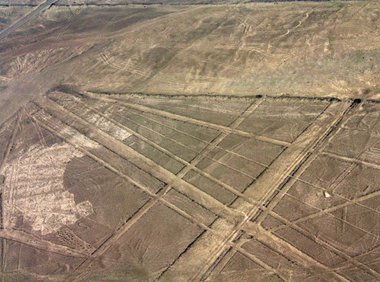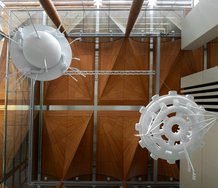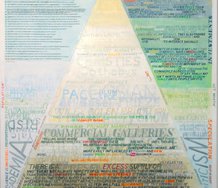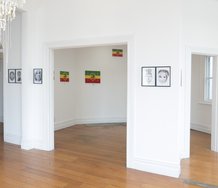Ralph Paine – 27 December, 2020
Hence: always make and exhibit art as fresh experiment, test out the undetermined and the determined, the underdetermined and the overdetermined. In-situ, 'People of Colour' was in no way un- or underdetermined. It was very precisely conceived and constructed. Precisely installed. Determined. A non-random set of flags printed on fabric, stretched on frames, hung salon-style. Of itself, the exhibition sang of exactitude. But yeah, then Insta got super-positioned.
EyeContact Essay #42
Dear X
Thanks for your latest communique, the talking points, etc. Random that your Colombian writing gig has coincided with the Mercy-Event. Your friend R’s museum project sounds remarkable, forcing you to enter the archaeology/ethnology zone, a zone of great affection pour moi, especially when viewed through the Deleuze & Guattari lens: Levi Strauss, Clastres, Leroi-Gourhan… And now the great D&G shaman apprentice Viveiros de Castro—wow! what an amazing book Cannibal Metaphysics is.
But you say R’s project is making for uneasy feelings. That an “ontology of art in which everything’s open, undetermined, a position held by French post-structuralism, and dating back to Romanticism’s enthusiasm for vitalism” is seeming a little redundant, not adequate for the tasks at hand in Bogota. I hear ya.
Different with Mercy’s People of Colour. Rather than undetermined/determined, I’m thinking underdetermined/overdetermined. Thus: PoC is a constellation of ideas, simulacra, picture-thoughts, of which the artists desired an underdetermined and open response. One coming from beyond good and evil, beyond all judgement machines, from a space akin to Spinoza’s third kind of knowledge. But no. Everything got way overdetermined, all psychologised ‘n’ subjectivised, moralistic, manic… A finalised, case closed, end of story and go fuck yourselves response. Crazy-weird-sad.
Perhaps Nina Power’s written piece didn’t help with this. The old wall-text/accompanying theoretical handout problem. Which in turn brings in the wider aspect of art’s current mode of production/mode of perception, inclusive of both social media and the white cube nexus, and thus a more widely dispersed Space of Reception—contemporary art and its constantly mutating public(s), the Aesthetic Regime… Difficult to underdetermine all that!
If social media gives “the masses” a new means of organising and regulating a response to a white cube or museum exhibition, what seems edgy and way fucked-up is that so often the organised responses are negative, iconoclastic, fascist: cancel culture, angry flash mob protests, death threats, vandalism, insulting and defamatory pronouncements, etc. The rest of the time it’s individual “likes” and unicorn emojis. Paul Virilio once said that every new technology brings in a new accident (his example was the car and the car crash). Guess then today we’re living in the Age of the Smartphone Accident, and this has gotta include rare-earth extraction and its connection to war, vast accumulations of e-waste, bio-surveillance, massive energy consumption, and blue-light & scrolling manias. The Wreckage.
All of which changes things for artists. Including the all-consuming issue of technique, manner, style… Random events, throws of the dice, accidents vs. very carefully chosen elements, tools, materials, formats, etc., sometimes to the point of overdetermination (when I feel the latter kicking in I know it’s time to mutate a little, to add or subtract some factor or other). Hence: always make and exhibit art as fresh experiment, test out the undetermined and the determined, the underdetermined and the overdetermined. In-situ, People of Colour was in no way un- or underdetermined. It was very precisely conceived and constructed. Precisely installed. Determined. A non-random set of flags printed on fabric, stretched on frames, hung salon-style. Of itself, the exhibition sang of exactitude. But yeah, then Insta got super-positioned.
In your case, with the Colombian glyphs, the images refuse to speak. There’s a temporal break, a rupture, a seemingly unbridgeable disconnect between the artists who made the rock face images and the people now living and working in the area i.e. those caring for, passing through, patrolling, exploiting, etc. this particular geo-zone. Does this mean that the images remain fully undetermined, thus allowing us to project anything we might desire onto them, any sense whatever?
What about the contemporary toolbox? The bricolage machine? Theory, art history, archaeology, ethnology, different kinds of local knowledge, indigenous thought, a constellation, assemblage of names, translations, understandings, diagrams, maps, tracings (always to be put back on the maps), processes. Isn’t this what R’s museum project is constructing, on the spot, a multi-perspectival Think Tank wherein an underdetermination of sense (the glyphs) is brought in some way toward contemporary collectivity and learning? Paradox: the past cannot be changed, and every generation changes it.
I’m crazy for images and studies of the Nazca lines in SW Peru. Again, no connection between the people who constructed these mega-glyphs and the people who live and work in the area today. The hypotheses concerning the “function” of the lines include: a vast astronomical map; a calendar—the beaks of some of the bird images indicate the points of sunrise on the days of the two solstices; markings for visitors from outer space—the sky-gods or alien theory; ritual treadmills; practical maps e.g. pointing the way to important sites, such as water sources… And archaeologists, often using drones, are discovering “new” mega-glyphs all the time.
In Aotearoa the situation is somewhat different. Māori often claim an intact and powerful continuity between the past, the present, the future. A continuity—whakapapa + storytelling + wairua-type connections to a primordial source + etc.—that has not been severed by colonialism, muskets, Christianity, the introduction of money and the commodity form, the English alphabet and the printing press, and so on to the Internet. Yet the Māori conceptual world overflows with intricately complex continuity/break problems e.g. the variations of the Tāne myth.
Sounds very labyrinthine between R, her university department, the museum in Bogota, and the indigenous artists she has been working alongside of. All the contradictions of class, race, gender, etc. plus the cultural appropriation thing! And all of it playing out in extreme conditions of a Sth American-type extractive capitalism—Marx in the Rainforest! An “anything goes” situation for the artists then? A wild frontier of code and affect creation? Why not? And maybe the artists’ responses to the artefacts in the museum’s collection were always already connected to both the pre-Columbian and the global, as found on the ground, and explored from where they see it, in all their indigeneity. As for who benefited cultural capital-wise, yes, no doubt the academic, the university, the museum. Question: “Where do we stand when we speak and make?”
Certain zones of anti-foundational thought might help here. Engagements with notions of situational relativity and complimentarity, a way of thinking which posits there are no actual points of view outside of situations. And further, anti-foundational thought maintains that even within given situations nor is there any exact still-point on which to stand or speak from. All is process. And in order to fathom process, we’re gonna require the complex fathomings of logical incompleteness, contradiction, philosophical paradox, and a taste for radical breaks. And in turn, this welcomes in a (cautious?) celebration of the free play of difference, of hybridity and fluidity of identity, and investigations into the possibility of non-essential being.
In the scheme of things named the history of ideas, there’s a contemporary version of anti-foundational thought that is said to have called in an end to Universal History and its “grand narratives,” and thus an end to Western, linear ideas of progress. And in their place, a resurrection and reinvention of “other” histories: her-stories, nomadic thought, indigenous forms of knowledge, etc. In Anti-Oedipus, Deleuze and Guattari give all this a wonderful twist by stating that there is in fact a Universal History, but that this history “comes at the end”—meaning with the real subsumption of the whole of life, i.e. all life-worlds, by Capital—and hence, Universal History is rejigged by D&G as: “the history of contingencies, and not the history of necessity… Ruptures and limits, and not continuity.” Meanwhile, Walter Benjamin believed that the only continuity in history is CATASTROPHE.
Not that any of this helps much with untangling the privilege formula: ranking + training = culture. Perhaps then a badly posed formula? Not sure. D&G’s concept “becoming-minoritarian” certainly reconfigures it. Here’s how I stated a personal account during an online conversation a few years back…
The Black Panthers used to say that even blacks must “become” black. In other words, praxis comes before being, politics before ontology. Which might just mean that today women must become woman, indigenous become indigenous, māori become māori, proletarians become proletarian, etc. etc. In my youth, the 60s and 70s, all around I witnessed an amazing and extremely powerful becoming-black-woman-indigenous-māori-proletariat, a linkage which can be singularised as: becoming-minoritarian. This becoming-minoritarian necessarily affected me, and so my choice was an attempt at entering the process, at tearing myself away from my majoritarian identity… Yeah, even on the bus.
Interesting what your nephew says about Internet social justice warriors who “don’t do anything constructive on the ground.” And I love it when he says “grass-roots political movements have to be ‘pragmatic’ in their approach to allies and enemies alike.” Yes, a lot of the time “pragmatic” doesn’t seem to be a thing on Instagram, Twitter, and the other platforms. More like take-no-prisoners drone warfare and fuck the collateral damage.
Kinda aristocratic of me, but I figure the artist’s life as an Autonomous Zone—and to be defended as such! So, I don’t regard my drawing, painting etc. as forms of activism. For a long time I was an admirer of art activism—Hans Haacke, Black Arts Movement (BAM), Martha Rosler, Guerrilla Girls, Pussy Riot—but less and less so of late. What’s changed? Capture by the institutions? A corporate take-over of disruptive thinking and resistance? The subsumption of the revolution into fashion and advertising? Massive propagation of the creative industries paradigm?
At the end of his Surrealism essay—and again in Author as Producer—Walter Benjamin asked what might have seemed some rather depressing questions for artists of the time e.g. “In order to become part of a new political function, might the abandonment of your art career be the way to go?” Guess a lot of water has flowed under the art-politics bridge since Benjamin posed that question, but it still resonates. Which returns me to the Mercy-Event. People of Colour was an amazing act of artistic abandonment, a prodigious new example of activism: simple, precise, explosive! Instead of taking a position within the current debate, Mercy EXPOSED the debate itself.
In the meantime, the Pohutukawa are in bloom…
Aroha nui & Happy X-to-the-max!
Rx
Recent Comments
Ralph Paine
II. But now comes the fully Delusional. Having nit-picked away at the virtues of artistic autonomy and freedom of expression ...
Ralph Paine
I. It was relatively easy dismissing Imogen Taylor’s little summertime attack on Mercy Pictures. To claim as she did that ...
Ralph Paine
Thank you JJ Harper! Interesting that you regard Nina Power’s text as simply another flag, symbol, or curated element of ...

 Two Rooms presents a program of residencies and projects
Two Rooms presents a program of residencies and projects Advertising in this column
Advertising in this column



This Discussion has 4 comments.
Comment
JJ Harper, 11:12 p.m. 28 December, 2020 #
"Instead of taking a position within the current debate, Mercy EXPOSED the debate itself". A lot of people have written off the exhibition as being a vapid misappropriation of semiotics 101 but to me it felt like POC did take a position of being anti-post-structuralism — anti-the entire vein of liberal art intellectualism that positions culture over politics. Power's text was just another symbol in the show that people took at face value, as a text instead of an artwork actively curated by Mercy. As Robert Leonard writes in his recent blog post Fools to Judge my Work, "Am I among the critics (judging the art) or at their mercy (making exhibitions alongside the artists)? No offence to monkeys". The curation in POC was immense and has been consistently overlooked in 'the discourse', by the fools who judge (like me). My thoughts have developed a lot on this show. I think people found POC so frustrating because it presented conflicting viewpoints and the hegemonic position is that conflict is quite literally abuse. Of course it's not, but that's not very profitable to the art institutional complex. Thanks for putting this out there Ralph, I liked the form of it!
Ralph Paine, 2:21 p.m. 29 December, 2020 #
Thank you JJ Harper!
Interesting that you regard Nina Power’s text as simply another flag, symbol, or curated element of PoC. Yeah, perhaps I’ve been granting the text too much interpretive force. Yet by neutralising this force, you now give more force to my assertion that “instead of taking a position within the current debate, Mercy EXPOSED the debate itself.” In other words, once Nina Power’s text is rendered as simply another flag-character set amidst myriad other flag-characters then there seems no way of ascertaining Mercy Picture’s position, no way of telling where they stood vis a vis post-structuralism, identity politics, or whatever.
Mercy’s technique might thus be named tableau, or montage, or even as a kind of theatre wherein the flags were presented as characters; a technique whereby a SITUATION is portrayed rather than any plot development occurring—the latter task being left entirely up to the viewers. Walter Benjamin writes about this in his “The Author as Producer” essay, suggesting there that this technique “disrupts the context in which it is inserted.”
Seems whack in the extreme then that so many artists, art teachers, and art commentators could not even recognise, let alone acknowledge, that PoC was employing this technique; or if they did recognise this, that they were so offended by Mercy’s wonderful use of it. So rather than Mercy falling into their own trap (as some have so arrogantly asserted), I’m figuring that it was the haters and condemners who fell into a trap set by Mercy, a trap that has left the dominant artworld ideologies, beliefs, techniques, etc. exposed and in complete tatters, as if a flag after a violent storm.
I do not believe that any artist wants to be determined as The Enemy. What we want is to elude, to escape determination. But sometimes, suddenly, we have no say in the matter. Sometimes our actions cause such a reaction that we have no choice. No choice but to become witches, sorcerers, heretics, scapegoats… At first, we draw a magic circle around ourselves and hum. We protect ourselves with amulets and incantations. With learning. We find ourselves reading, drawing, writing.
Ralph Paine, 11:44 a.m. 14 April, 2021 #
I.
It was relatively easy dismissing Imogen Taylor’s little summertime attack on Mercy Pictures. To claim as she did that the paintings hanging on Michael Lett’s walls were her defence of modernist legacies against the likes of People of Colour seemed straight-up-and-down Delusional—about as Delusional, let’s say, as Sarah “Senior Member of the Art World” Hopkinson’s newly found aspirations toward social justice warrior-hood. Boastful Signs indeed.
Given Mr Lett’s tortuous entwinement in the Mercy-Event, however, it wasn’t so easy reconciling the fact that he had gone ahead and published Ms Taylor’s statement in the first place. What was his Empathy-Brain thinking? Was it even operational? Probably not, or at least no more than Tim Melville’s, who in some twisted and fateful moment had decided on calling his first exhibition of the season Painters of Colour.
Whatever, but now along comes Tendai Mutambu with a forked-tongue editorial for the new essays section of ArtNow https://artnow.nz/essays/terms-of-art-now, yet another unhappy example of “Put the Empathy-Brain on ice and ramp up the Delusional.” If I were launching some new Art-thing right now I sure as hell wouldn’t be allying my venture with the deeply craven and downright destructive nature of the attacks on Mercy Pictures, Nina Power, and EyeContact.
But this is precisely what Mr Mutambu does, to the max. Lacking anything new to say about either the PoC exhibition or the attacks, Mr Mutambu’s editorial gets stuck on Repeat. Round ‘n’ round goes the stale doxa, gossip and innuendo, all reported-words in reporting-words, a compendium of misinformation, gloats ‘n’ smirks; nothing but sad passions and arrogant celebrations of pure negativity.
And all this wearisome BS so as suddenly to proclaim (O Horizon!) the rising up of what—now speaking in cultural revolution mode—he calls a “new guard”, some of whom (of course!) members of the initial attack force, others mere shadow dwellers, back-channel operators, feeble lookers-on (“we are monitoring the situation”) of the Mercy-Event.
Ralph Paine, 11:45 a.m. 14 April, 2021 #
II.
But now comes the fully Delusional. Having nit-picked away at the virtues of artistic autonomy and freedom of expression (apparently, because we are not yet Equal, neither of these virtues ought to be upheld), Mr Mutambu then claims for himself an independent voice and platform, and thus, we are led to believe, a rigour of criticality. WTF!!!###??? With damn near every art institution in the country financnzially backing his editorship, plus the essay section, how could this be?
Here’s the f_cked up logic: “in spite (or because) of” so many institutions making all this possible, Mr Mutambu reasons that none of them actually control anything, that any singular influence among them will be magically offset by the networked-All, and thus he will be free to speak and commission as an independent. What an incredulous theory of Power! Has he no experience / knowledge of the shifting ground of the political Real i.e., consensus, alliances, backroom and telephone deals, shared ideologies, PR ‘n’ spin, Night Councils, peer pressure, market forces, the coupling-decoupling-recoupling of desiring machines, curatorial spheres of influence (aka scenes ‘n’ trends or “Let’s do lunch”), bullying ‘n’ bribery, the Will of those who Govern, pillow talk, and so on and so forth? Carl von Clausewitz, On War, p. 402: “Is not War merely another kind of writing and language for political thoughts?”
In any case, the way I figure it is that Mr Mutambu is spin doctoring all this for the Man, aka the Institution, the Art Establishment, a business-as-usual Old Guard. In other words, by hiring out his keyboard to ArtNow he’s become nothing but a PsyOps Mercenary fighting on the WRONG SIDE of a civil war being conducted on the field of Art.
Participate
Register to Participate.
Sign in
Sign in to an existing account.